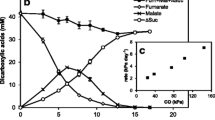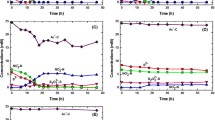Abstract
The physiology of the sulfur disproportionator Desulfocapsa sulfoexigens was investigated in batch cultures and in a pH-regulated continuously flushed fermentor system. It was shown that a sulphide scavanger in the form of ferric iron was not obligatory and that the control of pH allowed production of more biomass than was possible in carbonate buffered but unregulated batch cultures. Small amounts of sulphite were produced during disproportionation of elemental sulfur and thiosulphate. In addition, it was shown that in the presence of hydrogen, a respiratory type of process is favored before the disproportionation of sulphite, thiosulphate and elemental sulfur. Sulphate reduction was not observed. D. sulfoexigens assimilated inorganic carbon even in the presence of organic carbon sources. Inorganic carbon assimilation was probably catalyzed by the reverse CO-dehydrogenase pathway, which was supported by the constitutive expression of the gene encoding CO-dehydrogenase in cultures grown in the presence of acetate and by the high carbon fractionation values that are indicative of this pathway.
Similar content being viewed by others
References
Bak F. and Cypionka H. 1987. A novel type of energy metabolism involving fermentation of inorganic sulfur compounds. Nature 326: 891-892.
Bak F. and Pfennig N. 1987. Chemolithotrophic growth of Desulfovibrio sulfodismutans sp.nov. by disproportionation of inorganic sulfur compounds. Arch. Microbiol. 147: 184-189.
Canfield D. and Thamdrup B. 1994. The production of 34S-depleted sulphide during bacterial disproportionation of elemental sulfur. Science 266: 1973-1975.
Canfield D. and Thamdrup B. 1996. The fate of elemental sulfur in an intertidal sediment. FEMS Microbiol. Ecol. 19: 95-103.
Cline J.D. 1969. Spectrophotometric determination of hydrogen sulphide in natural waters. Limnol. Oceanogr. 14: 454-458.
Cypionka H., Smock A.M. and Böttcher M.E. 1998. A combined pathway of sulfur compound disproportionation in Desulfovivrio desulfuricans. FEMS Microbiol. Lett. 166: 181-186.
Dannenberg S., Kroder M., Dilling W. and Cypionka H. 1992. Oxidation of H, organic-compounds and inorganic sulfur-compounds coupled to reduction of O2 or nitrate by sulphate-reducing bacteria. Arch. Microbiol. 158: 93-99.
Diekert G.B. and Thauer R.K. 1978. Carbon monoxide oxidation by Clostridium thermoaceticum and Clostridium forwith micoaceticum. J. Bacteriol. 136: 597-606.
Fauque G.D. 1994. Sulfur reductase from thiophilic sulphate-reducing bacteria. In: Peck HD Jr. and LeGall J. (ed.), Methods in Enzymology. Academic Press, New York, Vol. 243:, pp. 353-367.
Finster K., Liesack W. and Thamdrup B. 1998. Elemental sulfur and thiosulphate disproportionation by Desulfocapsa sulfoexigens sp nov, a new anaerobic bacterium isolated from marine surface sediment. Appl. Environ. Microbiol. 61: 119-125.
Frederiksen T.M. and Finster K. 2003. Sulfite-oxido-reductase is involved in the oxidation of sulfite in Desulfocapsa sulfoexigens during disproportionation of thiosulfate and elemental sulfur. Biodegradation 14: 189-198.
Friedrich C.G., Rother D., Bardischewsky F., Quentmeier A. and Fischer J. 2001. Oxidation of reduced inorganic sulfur comdisproportionation pounds by bacteria: Emergence of a common mechanism? Appl. Environ. Microbiol. 67: 2873-2882.
Fuchs G. 1989. Alternative pathways of autotrophic CO2 fixation. In: Schlegel H.G. and Bowien B. (eds), Autotrophic Bacteria. Science Tech, New York, pp. 365-382.
Hallbeck L. and Pedersen K. 1991. Autotrophic and mixotrophic growth of Gallionella ferruginea. J. Gen. Microbiol. 137: 2657-2661.
Isaksen M. and Finster K. 1996. Suphate reduction in the root zone of the seagrass Zostera noltii om the intertidal flats of a coastal relagoon (Arcachon, France). Mar. Ecol. Prog. Ser. 157: 187-194.
Jansen P.H., Schuhmann A., Bak F. and Liesack W. 1996. Disproportionation of inorganic sulfur compounds by the sulphatereducing bacterium Desulfocapsa thiozymogenes gen. nov., sp. nov. Arch. Microbiol. 166: 184-192.
Jørgensen B.B. 1990. A thiosulphate shunt in the sulfur cycle of marine sediments. Science 249: 152-154.
Jørgensen B.B. and Bak F. 1991. Pathways and microbiology of thiosulphate transformations, and sulphate reduction in a marine sediment (Kattegat, Denmark). Appl. Environ. Microbiol. 57: 847-856.
Kappler U. and Dahl C. 2001. Enzymology and molecular biology of prokaryotic sulphite oxidation. FEMS Microbiol. Lett. 203: 1-9.
Kelly D.P., Shergill J.K., Lu W.P. and Wood A.P. 1997. Oxidative metabolism of inorganic sulfur compounds by bacteria. Antonie van Leeuwenhoek 71: 95-107.
Knoll A.H. and Canfield D.E. 1998. Isotopic interference on early ecosystems. In: Norris R.D. and Corfield R.M. (eds), Isotope Paleobiology and Paleoecology. The Paleontological Society Papers, Vol. 4:, pp. 212-243.
Krämer M. and Cypionka H. 1989. Sulphate formation via ATP-sulfurylase in thiosulphate-disproportionating and sulphite-disproportionating bacteria. Arch. Microbiol. 151: 232-237.
Langdahl B. and Ingvorsen K. 1997. Temperature characteristics of bacterial solubilisation and 14C assimilation in naturally exposed sulphide ore material at Citronen Fjord, North Greenland (83ºN). FEMS Microbiol. Ecol. 23: 275-283.
Lovley D.R. and Phillips E.J.P. 1986. Organic matter mineralization with reduction of ferric iron in anaerobic sediments. Appl. Environ. Microbiol. 51: 683-689.
Lovley D.R. and Phillips E.J.P. 1994. Novel processes for anaerobic sulphate production from elemental sulfur by sulphate reducing bacteria. Appl. Environ. Microbiol. 60: 2394-2399.
Mopper K. and Dalmas D. 1984. Trace determination of biological thiols by liquid chromatography and precolumn fluorometric labeling with o-phthalaldehyde. Anal. Chem. 56: 2557-2560.
Obraztsova A.Y., Francis C.A. and Tebo B.M. 2002. Sulfur dis-proportionation by the facultative anaerobe Pantoea agglomerans SP1 as a mechanism for chromium (VI) reduction. Geomicrobiol. J. 19: 121-132.
Pachmayr F. 1960. Vorkommen und Bestimmung von Schwefelverbindungen in Mineralwasser. PhD thesis. University München.
Thamdrup B., Finster K., Hansen J.W. and Bak F. 1993. Bacterial comdisproportionation of elemental sulfur coupled to chemical reduction of iron and manganese. Appl. Environ. Microbiol. 59: 101-108.
Author information
Authors and Affiliations
Rights and permissions
About this article
Cite this article
Frederiksen, TM., Finster, K. The transformation of inorganic sulfur compounds and the assimilation of organic and inorganic carbon by the sulfur disproportionating bacterium Desulfocapsa sulfoexigens . Antonie Van Leeuwenhoek 85, 141–149 (2004). https://doi.org/10.1023/B:ANTO.0000020153.82679.f4
Issue Date:
DOI: https://doi.org/10.1023/B:ANTO.0000020153.82679.f4




